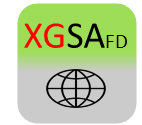Over and under Ground System Analysis in the Frequency Domain
XGSA_FD can be used for advanced electromagnetic interference and fields analysis of aboveground and underground systems in the frequency domain from DC to about 100 MHz and is commonly used for the evaluation of interference between power lines or cables and pipelines or telecommunication systems. This module can also calculate the electromagnetic force on conductors.
XGSA_FD contains GSA_FD and can be used also for advanced grounding systems analysis.
XGSA_FD includes the tools SRA and SA for soil resistivity analysis, soil resistivity seasonal analysis and multilayer soil modelling.
XGSA_FD is highly appreciated for its power and accuracy and for the wide field of application.

- General Description
- Input data (in addition to GSA)
- Output results (in addition to GSA)
- Main Features (in addition to GSA)
GSA is based on a PEEC static numerical model and to the equipotential condition of the electrodes and can analyse the low frequency performance of grounding systems composed by many distinct electrodes of any shape but with a limited size into a uniform or multilayer soil model.
GSA can take input data in the form of either graphical (from “dxf” files or from the integrated CAD) or numerical and render powerful graphical facilities via it’s optimised and validated computation algorithms, thus making it an indispensable tool for grounding system design and verification.
GSA includes the modules SRA to calculate multilayer soil model parameters starting from measured soil resistivity data and SA to calculate the effects of seasonal climate change.
GSA is essentially a low frequency tool but in several practical cases (with little electrodes), it can be also useful to calculate the impulse impedance of electrodes under lighting currents with an accuracy level adequate for many engineering applications.
-
Additional Electrical data (e.g. injected current or specified potential in an arbitrary number of points, impressed or induced EMF, operative frequency, additional longitudinal impedances, etc.)
-
Additional Geometrical data (topology of the conductors network, conductors and screened conductors cross section, coating thickness, material properties, etc.)
- Additional Physical data (e.g. soil permittivity, model for frequency dependence of soil parameters, etc.)
- Ground impedance and Ground Potential Rise of all reference points (ground impedance is calculated as ratio between its GPR of the specific point and the total injected current in the electrodes)
- Distribution of leakage current from the electrodes with 1D (magnitude, real and imaginary), 2D and 3D graphical representation to verify the efficiency of cpecific grounding system parts
- Distribution of longitudinal current (transferred or induced) on the electrodes with 1D (magnitude, real and imaginary), 2D and 3D graphical representation
- Distribution of potential (transferred or induced) on the electrodes with 1D (magnitude, real and imaginary), 2D and 3D graphical representation
- Distribution of electromotive force on the electrodes with 1D (magnitude, real and imaginary), 2D and 3D graphical representation
- Distribution of complex power on the electrodes with 1D (magnitude, real and imaginary), 2D and 3D graphical representation
- Magnetic field distributions on horizontal straight line or rectangular area with 1D, 2D and 3D coloured graphic representations, for individuation of safe and hazardous areas
-
Calculation model based on “PEEC” method in full-wave conditions
-
Automatic advanced debug of data before calculation
-
Automatic recognition of the connections between conductors
-
Possibility to consider the soil permittivity
-
Possibility to consider the frequency dependence of soil parameters and allows setting the used model choosing from the most established
-
Possibility to analyse up to 999 distinct underground electrodes on the same calculation
-
Possibility to consider additional longitudinal and transverse impedances
- Possibility to consider energization using both multiple current and voltage sources
- Possibility to analyse electrodes buried in a multizone soil model













